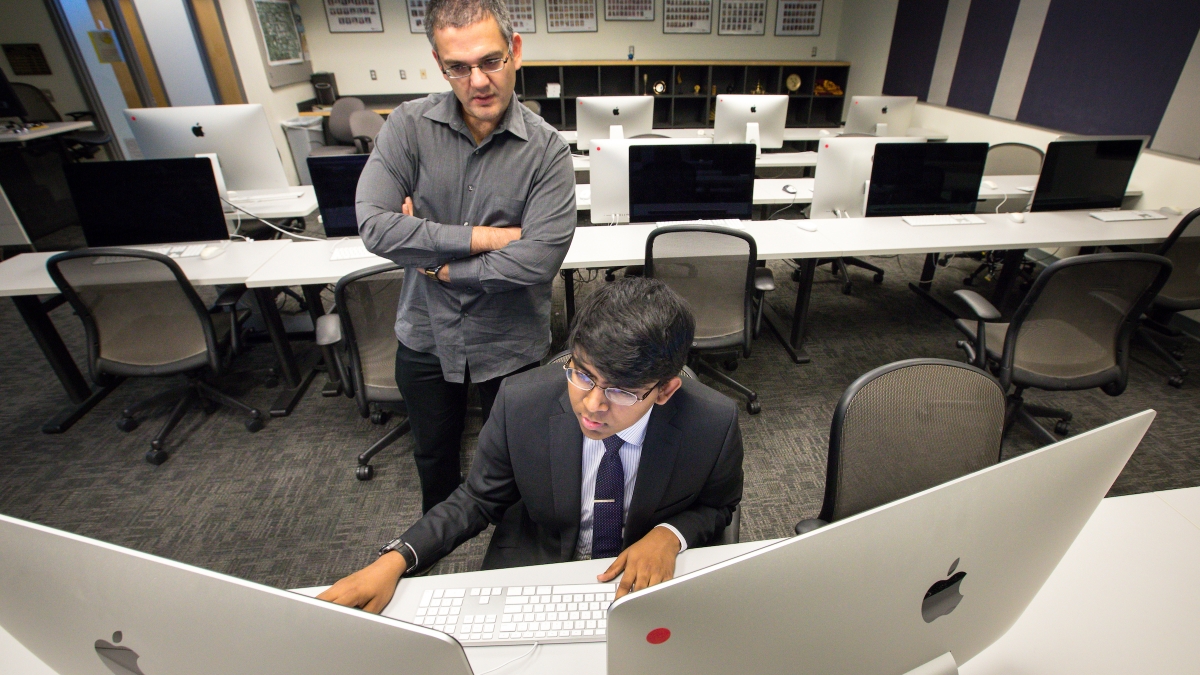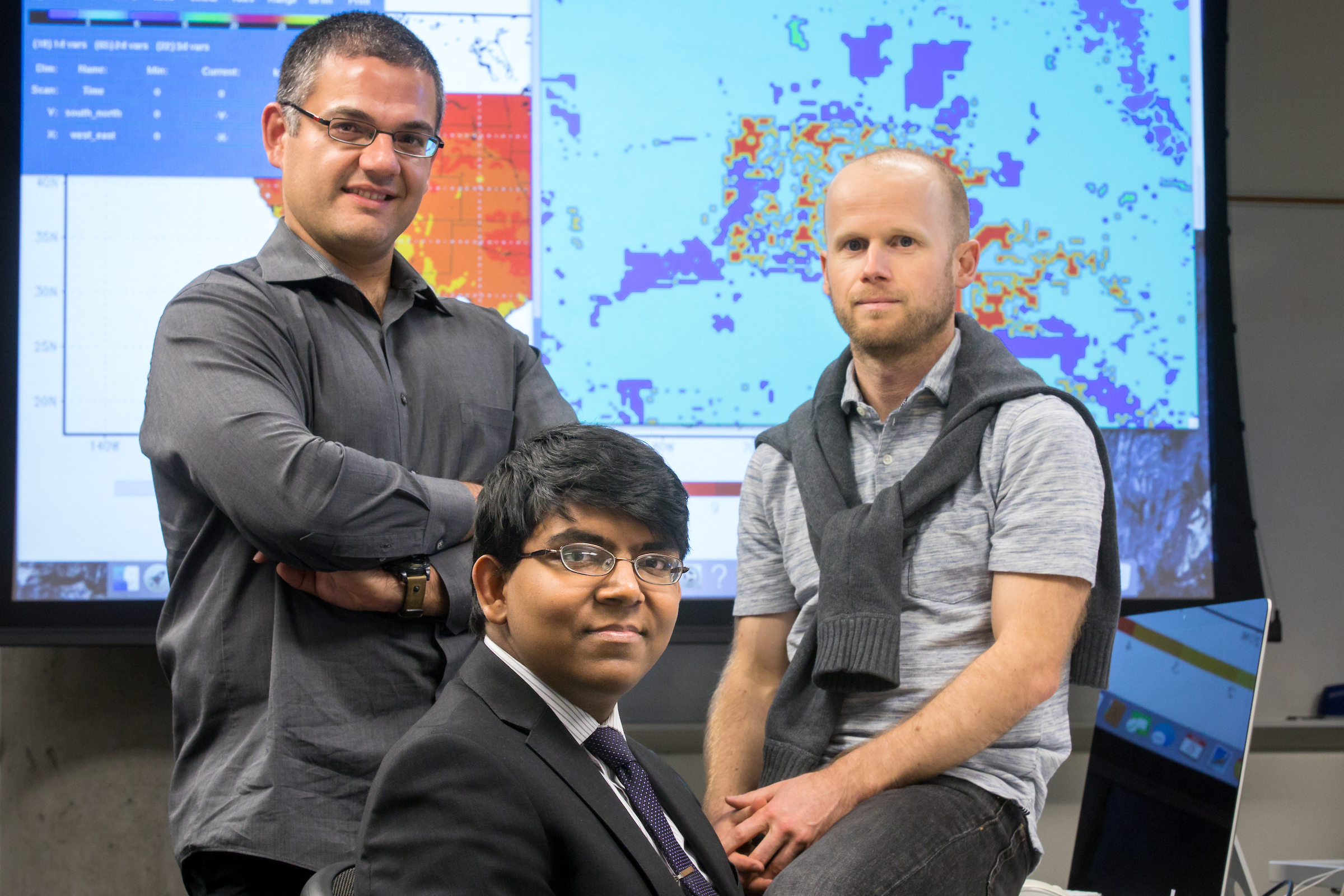Matei Georgescu uses a lot of data in his research, studying how a changing landscape can affect local climate and resources. He looks at how land changes, from undeveloped to developed, affect climate and rainfall and runs simulations that make long-term projections with the goal of finding a more sustainable future.
If it sounds like a lot of work, that’s because it is — and that’s where 16-year-old Vishesh Gupta comes in. The BASIS Scottsdale junior is a computer whiz and the rare example of a high school research assistant working in a top-tier lab.
“He is a junior in high school, and he has the technical abilities of a student who is entering grad school,” said Georgescu, an ASU associate professor in the School of Geographical Sciences and Urban Planning.
Georgescu and Gupta’s pairing reflects an innovative solution from ASU that helps a gifted community member excel and succeed to the peak of his potential.
Gupta’s interest in computers began in fifth grade when he took online tutorials on computer science. That summer, on his own, he built a web page for his adventures on “Super Mario Galaxy 2.”
“At the time, I thought this could be a hobby,” Gupta said.
Each summer since, Gupta would teach himself a new coding trick. But then what?
“I had done all of this computer work over the summers, but there weren’t any practical uses for it,” he said. “I learned all of this stuff, and then I didn’t know what to do with it.”
'He's been eager to help'
Georgescu and Gupta first crossed paths in April.
Gupta was looking for something to do with his computer skills when his older brother suggested he apply to work in Bruce Rittmann's lab at ASU’s Biodesign Institute.
Gupta was too young to work around chemicals, so Rittmann referred him to Georgescu, whose work uses ASU’s supercomputers to crunch data and make sense of disparate measurements.
For his part, Rittmann often welcomes high school students and teachers into in his lab to help and observe. He says the experience has propelled students.
“We have had several who have gone on to great success,” Rittmann said. “Our first intern was Smitha Ramakrishna, who eventually graduated from Harvard. Another early one was Emerson Reiter, who is a graduate of Stanford.”
Still, heading into the first meeting, Georgescu needed to be convinced that hiring a high school student was a good idea.
“I sat down with him and asked a few questions about climate change and climate variability,” Georgescu said. “I knew when we talked that he was insightful. He was asking probing questions. He had good questions about climate and our dialogue was just that, a two-way conversation revolving around methods and techniques, applicability of computers to the field of climate modeling. I was hooked.
“Now we are planning for Vishesh to be with us through the upcoming spring semester,” he added.
Gupta works most closely with Scott Krayenhoff, a postdoctoral researcher who projects climate and hydrology outcomes using data models.
Krayenhoff needed somebody to analyze the figures before they’re put into a simulation.
“Vishesh’s ability with data processing and analysis has been a great asset in our work,” Krayenhoff said. “He’s been eager to help and a quick learner.”
The projects they are working on include the Urban Water Innovation Network, of which Georgescu is ASU’s principal investigator as part of a 16-institution network. Another focuses on improving emergency preparedness during extreme-heat events in a partnership with Georgia Tech and the University of Michigan.
“We are trying to enhance our understanding of the urban environment, with an emphasis on human health impacts, energy demand and socioeconomic groups and vulnerable populations,” Georgescu said.
Gupta has constructed a database of observed extreme-heat events for the nearly two dozen regions of focus over the U.S., ranking them based on intensity and longevity to guide the historical simulations conducted for a variety of cities.
To do this, Gupta — without the security of a classroom setting — learned several new computer codes and software packages that analyze data types ranging from netCDF to binary. In months, Gupta taught himself GrADS, Python and R codes.
Sixteen-year-old Vishesh Gupta (front) poses in front of Phoenix climate data, with associate professor Matei Georgescu (left) and postdoctoral researcher Scott Krayenhoff. Photo by Charlie Leight/ASU Now
'This gives me a way to use it'
Georgescu now wants to recruit more high school students, saying they’re a valuable resource to tap. In return, he said, he can provide an enriching research experience.
“Vishesh is a 16-year-old, and he will be a co-author on our research,” Georgescu said.
For Gupta, the experience gives him a chance to expand his technological reach and pursue his passion in computer science.
“I have learned three computer languages and four scripting languages. Climate change is interesting, and I’d like to apply computer science to other disciplines, like architecture and astronomy.”
It also keeps his computer science skills sharp.
“I have this talent,” Gupta said. “This gives me a way to use it.”
Top photo: Sixteen-year-old Vishesh Gupta pulls up climate models on the computer with associate professor Matt Georgescu watching on Friday. The BASIS Scottsdale high junior works with Georgescu and postdoctoral researcher Scott Krayenhoff to analyze existing data to project outcomes on climate and hydrology as the result of certain types of land development. Photo by Charlie Leight/ASU Now
More Science and technology

ASU at the heart of the state's revitalized microelectronics industry
A stronger local economy, more reliable technology, and a future where our computers and devices do the impossible: that’s the transformation ASU is driving through its microelectronics research…

Breakthrough copper alloy achieves unprecedented high-temperature performance
A team of researchers from Arizona State University, the U.S. Army Research Laboratory, Lehigh University and Louisiana State University has developed a groundbreaking high-temperature copper alloy…

4 ASU researchers named senior members of the National Academy of Inventors
The National Academy of Inventors recently named four Arizona State University researchers as senior members to the prestigious organization.Professor Qiang Chen and associate professors Matthew…



